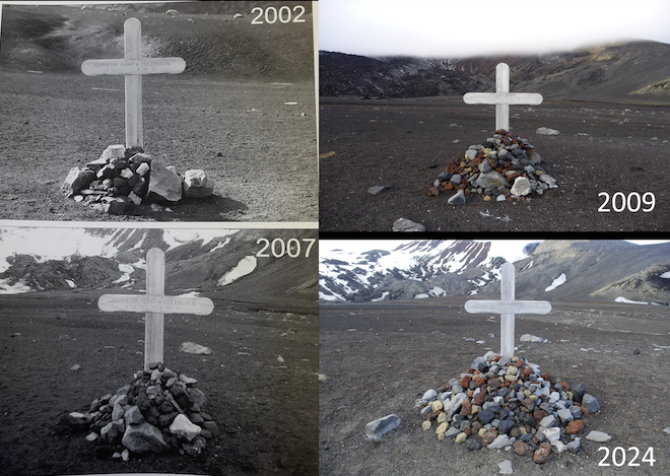Blog post
Antarctica Blog 5: Manage or remove?
Machiel Lamers and Daniela Cajiao are ENP researchers undertaking a scientific expedition to Antarctica in the context of the ANTARC-SHIP project. Their expedition takes place from mid-December 2023 until the end of January 2024. Stay tuned with this blog to hear the latest research updates, stories and adventures coming out of Antarctica!

Whaler's Bay
We are currently at the Spanish base Gabriel de Castilla on Deception Island. Deception Island is an active volcano, with an opening to the sea providing a natural harbour with a diameter of around five kilometers. Ships can enter the caldera, looking for shelter while enjoying an astonishing landscape. The island was used intensively from 1906 to 1931 for whaling ships and their associated industry. Currently, Whalers Bay (image above) belongs to the network of Antarctic Historic Site Monuments (HMS). HSM sites are designated for their historic value. In this site it is possible to still see some of the older structures (buildings and tanks) that enabled whaling activities. Whalers Bay also serves as a reminder of how human activities could cause long term negative consequences on the environment.
This site is among the five most popular visited sites in the Antarctic Peninsula. Each season around 10.000 passengers visit this site. Through the years Antarctic stakeholders have raised questions about the need to keep (while performing maintenance of the structures) or remove these remains that, little by little, are becoming debris contributing less to the learning of passengers but could also be a threat to species looking for shelter in these structures. Does the historic values of these buildings outweigh their environmental impacts? Is the removal of these structures (economically) feasible? Are these structures changing or degrading over time as a result of weathering of human impact?
Visualising change
One of the ways to answer these questions is by establishing the source and rate of degradation of these sites. As part of our research on environmental stewardship we have carried out a small repeat photography project at Whalers Bay. We attempted to repeat photographs taken in the 1990s and early 2000s by Dutch researchers, and pictures that we took in 2009 and on this expedition in 2024, of the same objects or scenes, to visualize changes or impacts. The first set of pictures (image below) shows the grave of Gulliksen in 2002, 2007, 2009 and 2024. First, it should be noted that this grave was moved from another location on Deception Island to Whalers Bay in 2002. So what you are looking at is not the original location of the grave. Second, it is evident that over the years the number of stones that have been added at the base of the cross has grown substantially. The only logical explanation is that visitors have been adding these stones to this grave over the years.

Heritage or waste?
The second example (image below) is of a house that in the early 1990s was relatively intact, but that shows severe degradation over the years. In 2024, we can conclude that not much is left but a heap of wooden beams. In this case the explanation for the degradation is likely weathering. A key question is of course how we manage such a place with great historical and natural value, but that is also susceptible to degradation and impact? Do we simply leave these structures, and allow materials to fly around in the Antarctic winds? Does it make more sense to take away the degraded parts of these structures in order for it not to impact the environment, and provide quality interpretation? From an environmental stewardship perspective the latter option makes much more sense. What do you think? Heritage or waste? Manage or remove?
